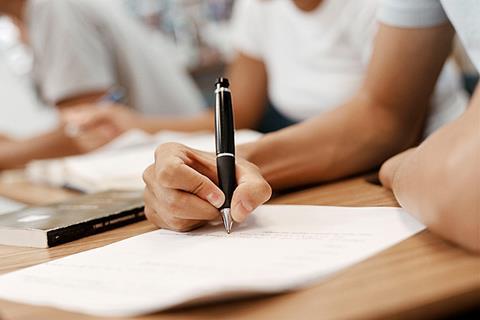Adrian Tennant looks at ways in which teachers can assess lessons in order to judge the success of both their classroom delivery and students’ learning.

Introduction
Most of the articles in this series deal with assessing our students’ ability to use English. However, one form of assessment that teachers often carry out is on themselves and their lessons.
When we assess our students we are trying to gauge how successful they have been in terms of learning particular aspects of English. In most of these we are assessing what they have been taught. The exception is when we give a diagnostic test in order to find out what the students already know (either from their previous lessons or other learning situations). If at any other time we are assessing them on something we haven’t taught, then is this really fair?
If our students don’t do particularly well when assessed we can, of course, say that they haven’t learnt very well. On the other hand, it might be the teaching that has failed and not the students. We should never assume that the fault lies with the student and should be willing to look ourselves and question whether the teaching was as effective as it could have been.
Assessing our aims
One place to start is by looking at our aims in a particular lesson or task. Every time we teach we should have an aim in terms of what we expect our students to get from the tasks. We often think these aims are clear and that the tasks and overall lesson match them perfectly. However, this is often not the case. It is always worth looking back at the stated aim and the lesson or task, to check that they really do match.
For example, you design a role-play in order to practise a specific piece of language you have taught during the lesson. For some reason the students haven’t used the language you wanted them to. Does this necessarily mean the students haven’t learnt the language you taught? No, not necessarily. It may be that the role-play itself could be done without that language; it may be that the students didn’t feel comfortable with the new language and therefore avoided using it; or it could mean that the activities used to teach the language didn’t work. As you can see, there are many reasons that need to be taken into consideration, and we shouldn’t simply assume that it is the students who are at fault.
Lesson observations
One way of assessing a lesson or tasks is through observation. If the aim of the observation is to look at the success of the lesson or particular activity then there needs to be a procedure in place to ensure that it is effective.
To start with, there needs to be a pre-lesson meeting between the observer and the teacher. In this meeting they should discuss the aims of the lesson and/or particular tasks, the criteria that will be used to assess the lesson, any issues surrounding the particular class/lesson, how long the observation will be and, finally, when and how the feedback will be conducted. This meeting is important if the observation is going to be successful as teaching is context dependent, and it’s important that the teacher discusses all these topics with the observer.
During the observation the observer should make notes in the form of questions wherever possible. The main rationale behind this is that what you can observe in the classroom is the action and not the thought process.
Finally, feedback should be positive and designed to explore issues, clarify what happened and get the teacher to think about the lesson. The observer should also relay whether or not it was as effective as it could have been and how it could be improved.
Peer observations
Of course, there is no reason why the observation needs to be carried out by a manager, director of studies or senior teacher. Some of the most effective observations are those carried out by other teachers, and not necessarily by those who are more experienced. There are some very simple questions / sentences that can be used to make the observation extremely beneficial. For example:
Why did you do X?
When you did X, what do you think happened?
I was really interested when you did X, I usually do Y.
Questions / sentences like these help the teach reflect on what happened and examine whether or not the teaching was effective or not.
Asking our students
One of the best ways to assess our teaching is to actually ask the students. There are a number of ways in which we can do this other than directly asking them, ‘Was that good for you?' Here are a few:
Mini-reflection questionnaire
This is a very simple method. Write the following three questions on the board and ask your students to write their answers on a piece of paper and drop them into a box on their way out:
Did you learn anything new?
In what way do you think what you learnt today will be useful for you?
Point out that the answers are anonymous and you’re not interested in who wrote them – the reason for this is that you tend to get more accurate feedback than if you ask them to put their name on it. Although, as you build a rapport it becomes easier to get good feedback as students realise you are not assessing them but what has happened in the lesson and your own teaching.
You’ll often find the results of this quite amazing. For example, in a class of twenty students you’ll find that there are probably ten different things they learnt (even when you thought you were only teaching one or two things). This mismatch between what you teach and what your students learn is quite fascinating. It certainly doesn’t mean you taught badly, but it is definitely food for thought.
A blind dictation
At the end of a class tell your students you are going to dictate some sentences to them. However, you do not want them to write down all the sentences but only the ones that are true for them. Give a couple of examples, i.e. I’m male (only the men / boys should be writing). I’m a student (all of the students should write). Now dictate some of the following sentences:
I learnt something new today.
I understood today’s lesson.
I didn’t understand the second task.
I know how to use X.
There is no need to collect the sentences in or even check the dictation, although if you want to put the students into pairs and get them to compare and discuss the sentences they wrote down then that’s fine. The main idea is that you can see who is writing each sentence down and it gives you a reasonable idea of how the lesson went. By keeping it private and not collecting in the sentences, you are (again) likely to get more accurate feedback.
The post-class lesson aims
Teachers are often asked to write down the aims of their lesson and what they are going to teach prior to the lesson. This is a way of getting your students to write a record at the end of the class.
Put the students into small groups of between three and five students. Each group should have a piece of paper and one person to act as scribe. On the sheet of paper the scribe should write the following:
Today we did …
Today we learnt …
The most useful thing today was …
We’re not sure about …
We would like more practice with … from today’s lesson.
Give the groups 5-10 minutes to discuss and write down their thoughts. If time is short you could do this at the end of the week rather than the end of every lesson. In some ways this is similar to the mini-reflection but is a written record that is used as a summary of what has actually been taught / learnt. These can then either be put on the walls and left for a few lessons, or can be kept in a file for the teacher’s reference.
Whatever technique you use, asking your students for feedback has got to be an extremely valuable exercise. After all, it is the students who are meant to be the focus of our attention. They are the ones who should be learning and who, most of the time, are the ones facing assessment.
Assessment matters: Designing your own tests

Adrian Tennant explores some of the issues behind designing your own tests and gives some practical examples of how to go about it.
- 1
- 2
- 3
- 4
- 5
 Currently
reading
Currently
reading
Assessment matters: Assessing tasks and lessons
- 7
- 8
- 9
- 10
- 11



















No comments yet